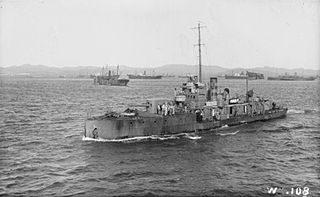
The M29 class comprised five monitors of the Royal Navy, all built and launched during 1915.
HMS Prince Eugene was one of eight Lord Clive-class monitors built for the Royal Navy in 1915 to conduct shore bombardments during the First World War. The ship was assigned to the Dover Patrol for the duration of the war and provided cover for the Inshore Squadron during the First Ostend Raid. She was sold for scrap in 1921.

HMS M29 was a Royal Navy M29-class monitor of the First World War. The ship was constructed by Harland & Wolff, in Belfast and launched on 22 May 1915, she was completed in June 1915. During World War I, the monitor served in the Mediterranean Sea at the Battle of Jaffa in 1917 and took part in operations in support of British and White Russian forces in the White Sea during the Russian Civil War in 1919. The ship was then converted to a minelayer and renamed HMS Medusa in 1925. In 1941 Medusa was converted to a repair and depot ship and was renamed HMS Talbot, then renamed HMS Medway II in 1944. In 1946, the vessel was sold for scrap.

HMS M30 was a Royal Navy M29-class monitor of the First World War.

HMS M31 was an M29-class monitor of the Royal Navy.
HMS Lassoo was a Laforey-class destroyer built for the Royal Navy during the 1910s.
HMS M28 was a First World War Royal Navy M15-class monitor. She was sunk during the Battle of Imbros in 1918.

HMS Louis was a Laforey-class destroyer built for the British Royal Navy during the 1910s. She participated in the Dardanelles campaign, during which she was wrecked in Suvla Bay in 1915.
HMS M27 was a First World War Royal Navy M15-class monitor. She was also served in the British intervention in Russia in 1919, and was scuttled in the Dvina River on 16 September 1919.
HMS M25 was a First World War Royal Navy M15-class monitor. She was also served in the British intervention in Russia in 1919, and was scuttled in the Dvina River on 16 September 1919.
HMS M26 was a First World War Royal Navy M15-class monitor.

HMS M21 was a First World War Royal Navy M15-class monitor. After service in the Mediterranean and the Dover Patrol, she struck a mine off Ostend in January 1918 and sank off Dover.
HMS M19 was a First World War Royal Navy M15-class monitor.
HMS M22 was a First World War Royal Navy M15-class monitor. Later converted to a minelayer and renamed HMS Medea, she was wrecked whilst being towed for breaking up on 2 January 1939.
HMS M23 was a First World War Royal Navy M15-class monitor. After service in the Mediterranean and the Dover Patrol, she was also served in the British intervention in Russia in 1919. Converted to the RNVR drillship Claverhouse in 1922, she served in that capacity at "Leith" until 1958.
HMS M24 was a First World War Royal Navy M15-class monitor. After service in the Dover Patrol, she was also served in the British intervention in Russia in 1919. She was sold in mercantile service in 1920.
HMS M18 was a M15-class monitor built for the Royal Navy during the First World War.

HMS M17 was a First World War Royal Navy M15-class monitor.
HMS M16 was a First World War Royal Navy M15-class monitor.

HMS M15 was a First World War Royal Navy M15-class monitor. She was sunk off Gaza by UC-38 on 11 November 1917.







